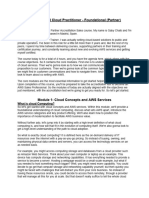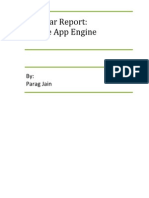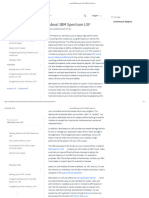0 ratings0% found this document useful (0 votes)
28 viewsBefore The Cloud - Example 1 - Online Shopping App
Before The Cloud - Example 1 - Online Shopping App
Uploaded by
Navneet KumarThe document discusses challenges and solutions for resource provisioning before cloud computing. It provides two examples:
1. An online shopping app that had peak usage during holidays and weekends. Before cloud, they would procure infrastructure for peak load, leaving it underutilized otherwise.
2. A startup that faced sudden increased load if it became popular. Before cloud, they would have to procure infrastructure assuming success, wasting resources if unsuccessful.
Other challenges mentioned are high infrastructure costs, lack of flexibility, low utilization, and needing dedicated maintenance teams. The document then introduces cloud computing as a solution, allowing on-demand provisioning and releasing of resources to match needs.
Copyright:
© All Rights Reserved
Available Formats
Download as DOCX, PDF, TXT or read online from Scribd
Before The Cloud - Example 1 - Online Shopping App
Before The Cloud - Example 1 - Online Shopping App
Uploaded by
Navneet Kumar0 ratings0% found this document useful (0 votes)
28 views11 pagesThe document discusses challenges and solutions for resource provisioning before cloud computing. It provides two examples:
1. An online shopping app that had peak usage during holidays and weekends. Before cloud, they would procure infrastructure for peak load, leaving it underutilized otherwise.
2. A startup that faced sudden increased load if it became popular. Before cloud, they would have to procure infrastructure assuming success, wasting resources if unsuccessful.
Other challenges mentioned are high infrastructure costs, lack of flexibility, low utilization, and needing dedicated maintenance teams. The document then introduces cloud computing as a solution, allowing on-demand provisioning and releasing of resources to match needs.
Original Title
Untitled
Copyright
© © All Rights Reserved
Available Formats
DOCX, PDF, TXT or read online from Scribd
Share this document
Did you find this document useful?
Is this content inappropriate?
The document discusses challenges and solutions for resource provisioning before cloud computing. It provides two examples:
1. An online shopping app that had peak usage during holidays and weekends. Before cloud, they would procure infrastructure for peak load, leaving it underutilized otherwise.
2. A startup that faced sudden increased load if it became popular. Before cloud, they would have to procure infrastructure assuming success, wasting resources if unsuccessful.
Other challenges mentioned are high infrastructure costs, lack of flexibility, low utilization, and needing dedicated maintenance teams. The document then introduces cloud computing as a solution, allowing on-demand provisioning and releasing of resources to match needs.
Copyright:
© All Rights Reserved
Available Formats
Download as DOCX, PDF, TXT or read online from Scribd
Download as docx, pdf, or txt
0 ratings0% found this document useful (0 votes)
28 views11 pagesBefore The Cloud - Example 1 - Online Shopping App
Before The Cloud - Example 1 - Online Shopping App
Uploaded by
Navneet KumarThe document discusses challenges and solutions for resource provisioning before cloud computing. It provides two examples:
1. An online shopping app that had peak usage during holidays and weekends. Before cloud, they would procure infrastructure for peak load, leaving it underutilized otherwise.
2. A startup that faced sudden increased load if it became popular. Before cloud, they would have to procure infrastructure assuming success, wasting resources if unsuccessful.
Other challenges mentioned are high infrastructure costs, lack of flexibility, low utilization, and needing dedicated maintenance teams. The document then introduces cloud computing as a solution, allowing on-demand provisioning and releasing of resources to match needs.
Copyright:
© All Rights Reserved
Available Formats
Download as DOCX, PDF, TXT or read online from Scribd
Download as docx, pdf, or txt
You are on page 1of 11
Before the cloud – Example 1 – Online Shopping App
Challenge:
Peak usages during holidays and Weekends.
Less load during less of the time.
Solution (Before the Cloud)
Procure (Buy) infrastructure for peak load.
Before the cloud – Example 2 – Start-up
Challenge:
It suddenly becomes popular.
How to handle sudden increase in Load?
Solution (before the Cloud)
Procure (Buy) infrastructure assuming they would be successful.
o What if they are not successful?
Before the cloud – Challenges
High cost of procuring Infrastructure.
Needs ahead of Time Planning (Can you guess the future?)
Low infrastructure utilization.
Dedicated infrastructure maintenance team (Can a start-up afford it?)
Silver Lining in the Cloud
How about provisioning (renting) resources when you want them and releasing them back
when you don’t need them?
This is also called on–Demand resource provisioning.
Also called Elasticity.
Cloud – Advantages
Trade “capital expense” for “variable expense”.
What is Capital expense: - It’s something which we put ahead of time.
What is variable expense: - We are renting resource on cloud based on the needs and once
we use them, we can release them back.
Benefit from massive economics of scale.
Stop guessing capacity.
Increase speed and agility.
Stop spending money running and maintaining the data centers.
“Go Global” in minutes.
Amazon Web Services (AWS)
It’s the leading cloud services provider.
Competitors for AWS: - Azure and Google Cloud.
Provides most (200+) services.
Reliable, secure and cost effective.
Best path to learn AWS!
Cloud applications make use of multiple AWS services.
There is no single path to learn these services independently.
However, I have worked out a simple path!
Setting up AWS account
Create AWS account.
Setup an IAM user.
You are creating your “AWS Root Account”.
Now we will understand types of Users
Root User: - When we first time we created the AWS account with the email id and
password, this is what we called Root user. The root user can be used for both Console
access as well as programmatic access to the application. The root user has complete
access everything within AWS account. He/she can even close anybody AWS account. So,
it’s strongly recommended not to use Root user for your day-to-day activities, even for the
administrative activities. It’s better to create different set of users called the IAM users
(Identity and Access Management). Therefore, the only things we should do with Root
user is to first create an IAM user and lock down the credentials somewhere secure.
Now, we will see how to create IAM user.
You might also like
- AWS Academy Cloud Foundations Module 01 Student Guide: 100-ACCLFO-20-EN-SGDocument49 pagesAWS Academy Cloud Foundations Module 01 Student Guide: 100-ACCLFO-20-EN-SGperbankan100% (3)
- E1Document22 pagesE1Durga Prasad YedidaNo ratings yet
- Aws NotesDocument20 pagesAws Notesriya varghese100% (11)
- IT NINJA-CPA-Review-BEC-Notes ITDocument24 pagesIT NINJA-CPA-Review-BEC-Notes ITSāikrushna KāvūriNo ratings yet
- A Comprehensive Guide To Building A Scalable Web App On Amazon Web Services - Part 1 PDFDocument45 pagesA Comprehensive Guide To Building A Scalable Web App On Amazon Web Services - Part 1 PDFTro WactNo ratings yet
- Questions With Answers On Cloud Computin PDFDocument3 pagesQuestions With Answers On Cloud Computin PDFmanaliNo ratings yet
- AZ-900T01 Microsoft Azure Fundamentals-02Document27 pagesAZ-900T01 Microsoft Azure Fundamentals-02SummonNo ratings yet
- AWS Certified Cloud Practitioner - FoundationalDocument56 pagesAWS Certified Cloud Practitioner - FoundationalcarolekzeroandoneNo ratings yet
- Interview PrepDocument131 pagesInterview PrepStudy CircleNo ratings yet
- Pravallika Jampana Summer Internship PDFDocument35 pagesPravallika Jampana Summer Internship PDFsrihitha1403No ratings yet
- M.VIJAY RAJ - Summer - Internship PDFDocument34 pagesM.VIJAY RAJ - Summer - Internship PDFsrihitha1403No ratings yet
- AWS NotesDocument45 pagesAWS NotesKavaljeet Kaur100% (2)
- Interview QuestionsDocument4 pagesInterview QuestionsEswari DeviNo ratings yet
- AWS ConceptsDocument6 pagesAWS ConceptsOMRoutNo ratings yet
- Chapter 1 NotesDocument24 pagesChapter 1 NotesAnekket DharaneNo ratings yet
- What Is Cloud Computing?: Demand Delivery of Computing Power, DB Storage, Apps, and More. This Means That We PayDocument47 pagesWhat Is Cloud Computing?: Demand Delivery of Computing Power, DB Storage, Apps, and More. This Means That We Paydanielshvartz2020No ratings yet
- AWS Cloud IntroDocument171 pagesAWS Cloud Introrequirement aie100% (1)
- Cloud Computing - ppt11Document33 pagesCloud Computing - ppt11Abhishek Kumar Anand100% (1)
- Tips-And-Tricks-To-Speed-Aws-Deployment PDFDocument7 pagesTips-And-Tricks-To-Speed-Aws-Deployment PDFthecoinmaniac hodlNo ratings yet
- AWS Cloud NotesDocument36 pagesAWS Cloud NotesTiffany ToureNo ratings yet
- Cloud Computing Assignment Questions 1st April 2021Document5 pagesCloud Computing Assignment Questions 1st April 2021Kiran Sk100% (1)
- What Is A Client-Server Model?Document4 pagesWhat Is A Client-Server Model?lavishak17No ratings yet
- Azure Fundamentals AZ-900Document42 pagesAzure Fundamentals AZ-900Animisha SomayajulaNo ratings yet
- Azure Interview Questions and Answers-2Document20 pagesAzure Interview Questions and Answers-2M. Tanveer BhattíNo ratings yet
- 100 Acfnds 10 en M1SGDocument116 pages100 Acfnds 10 en M1SGSantiago100% (1)
- Az900 Azure FundamentalDocument53 pagesAz900 Azure FundamentalMohamed RafickNo ratings yet
- Aws Q N ADocument9 pagesAws Q N AOMRoutNo ratings yet
- How Databases Can Meet The Demands of Cloud ComputingDocument6 pagesHow Databases Can Meet The Demands of Cloud ComputingmissshraddhasatpathyNo ratings yet
- AMAZON+AWS+Interview+Questions+and+Answers TrackedDocument11 pagesAMAZON+AWS+Interview+Questions+and+Answers TrackedErnestNo ratings yet
- Subtitulos Nse2 Modulo 1Document3 pagesSubtitulos Nse2 Modulo 1Jaime SaavedraNo ratings yet
- What Is Cloud ComputingDocument18 pagesWhat Is Cloud ComputingAnish SunchuNo ratings yet
- AWSDocument11 pagesAWSManish KumarNo ratings yet
- Cloud Computing - Lecture MaterialDocument14 pagesCloud Computing - Lecture Materialchirayush chakrabortyNo ratings yet
- What Is Cloud Computing (1) .EditedDocument8 pagesWhat Is Cloud Computing (1) .EditedIntissar SalhiNo ratings yet
- AWS - EbookDocument34 pagesAWS - EbookjakirNo ratings yet
- Azure Fundamentals Course BookDocument324 pagesAzure Fundamentals Course BookPrijesh Ramani100% (1)
- ContentDocument9 pagesContentSathish LoalNo ratings yet
- AWS Cloud Practitioner Official ModulesDocument144 pagesAWS Cloud Practitioner Official ModulesRushi Deore100% (2)
- Unit5 - CCV Notes - VII SemDocument18 pagesUnit5 - CCV Notes - VII SemRekha ManideepNo ratings yet
- vss a#2 group -2Document20 pagesvss a#2 group -2rab2.78khan8No ratings yet
- Cloud Computing QuestionsDocument7 pagesCloud Computing Questionstejinder kaurNo ratings yet
- AWS Cloud Practioner Certification Preparation GuideDocument12 pagesAWS Cloud Practioner Certification Preparation GuideDavid JosephNo ratings yet
- Google App EngineDocument14 pagesGoogle App EnginePARAGJAIN000100% (1)
- AWS ReStartDocument15 pagesAWS ReStartEbby AnneNo ratings yet
- Expert AWS Cheat SheetDocument12 pagesExpert AWS Cheat Sheetselva67% (3)
- 1 - 2. Lecture - Introduction To Cloud Computing (FULL)Document118 pages1 - 2. Lecture - Introduction To Cloud Computing (FULL)hdsasdadNo ratings yet
- Aws Cloud PractitionerDocument4 pagesAws Cloud Practitionerxavier mokhtarNo ratings yet
- Deployment Models For Cloud ComputingDocument3 pagesDeployment Models For Cloud ComputingtesscarcamoNo ratings yet
- The Illustrated AWS Cloud: A Guide to Help You on Your Cloud Practitioner JourneyFrom EverandThe Illustrated AWS Cloud: A Guide to Help You on Your Cloud Practitioner JourneyNo ratings yet
- Unit-3 IOTDocument17 pagesUnit-3 IOTJyoti GodaraNo ratings yet
- What Is Aws?: Saas (Software As A Service)Document16 pagesWhat Is Aws?: Saas (Software As A Service)Vijayprakashreddy BvprNo ratings yet
- Lec 2ndDocument16 pagesLec 2ndapandey71357No ratings yet
- AZ-900T01 Microsoft Azure Fundamentals-01Document21 pagesAZ-900T01 Microsoft Azure Fundamentals-01ngszehinNo ratings yet
- Top 100 AWS Interview Questions and Answers in - 2022Document31 pagesTop 100 AWS Interview Questions and Answers in - 2022Udaysinha PatilNo ratings yet
- Questions With Answers On Cloud ComputingDocument3 pagesQuestions With Answers On Cloud ComputingVishal Jain67% (3)
- CH 1Document21 pagesCH 1Noor aldeenNo ratings yet
- Oracle Cloud Infrastructure FoundationsDocument15 pagesOracle Cloud Infrastructure FoundationsVanioRamos100% (1)
- Satellite Campus, AmethiDocument10 pagesSatellite Campus, Amethivinay mauryaNo ratings yet
- Features of Cloud Computing - JavatpointDocument14 pagesFeatures of Cloud Computing - Javatpointmanoharkavuru14No ratings yet
- Amazon Web ServicesDocument96 pagesAmazon Web Servicesmihirmmb100% (1)
- Amazon Web ServicesDocument32 pagesAmazon Web Servicesapurva trehanNo ratings yet
- Result Sheet VGTAP Student - 7th BatchDocument6 pagesResult Sheet VGTAP Student - 7th BatchNavneet KumarNo ratings yet
- Important Technical Questions 1Document16 pagesImportant Technical Questions 1Navneet KumarNo ratings yet
- Firedetectionandalarmsystems 090512042400 Phpapp01Document38 pagesFiredetectionandalarmsystems 090512042400 Phpapp01Navneet KumarNo ratings yet
- SimplyDocument8 pagesSimplyNavneet KumarNo ratings yet
- LO2a) - Introduction To Data EngineeringDocument32 pagesLO2a) - Introduction To Data EngineeringAli Azgar KathaNo ratings yet
- Cminaccre A Mindoro State University Cloud Based Accreditation Management SystemDocument11 pagesCminaccre A Mindoro State University Cloud Based Accreditation Management SystemClarisse Nicole AdevaNo ratings yet
- Zim Gps TrackingDocument9 pagesZim Gps TrackingTanaka A.J. GotoraNo ratings yet
- OpenSAP Sac4 Week 04 Unit 01 ExerciseDocument9 pagesOpenSAP Sac4 Week 04 Unit 01 ExerciseAlena PritulaNo ratings yet
- Wei RenDocument8 pagesWei RenHarry TLNo ratings yet
- Adobe Experience Manager Architect: Adobe Certified Expert Exam GuideDocument8 pagesAdobe Experience Manager Architect: Adobe Certified Expert Exam GuideZjadacz AntymateriiNo ratings yet
- Key Technical ConceptsDocument69 pagesKey Technical ConceptsAin AnuarNo ratings yet
- BRICS Innovation ForumDocument14 pagesBRICS Innovation ForumSarah MasriNo ratings yet
- Cloud ComputingDocument16 pagesCloud ComputingRahul GuptaNo ratings yet
- Az Project 104Document25 pagesAz Project 104Raashid ShahabNo ratings yet
- About IBM Spectrum LSF - IBM Cloud DocsDocument5 pagesAbout IBM Spectrum LSF - IBM Cloud Docssatyab172No ratings yet
- Joachim Wuermeling: Exploring DORA - The Digital Operational Resilience Act and Its Impact On Banks and Their SupervisorsDocument5 pagesJoachim Wuermeling: Exploring DORA - The Digital Operational Resilience Act and Its Impact On Banks and Their SupervisorslouisemaemaglalangNo ratings yet
- Meraki WLAN Solution ComparisonDocument5 pagesMeraki WLAN Solution ComparisonAdrian Gamboa MarcellanaNo ratings yet
- Auto Compete RuleDocument11 pagesAuto Compete RuleTarek IbrahimNo ratings yet
- (1Z0-1042) Oracle Cloud Platform Application Integration 2019 AssociateDocument14 pages(1Z0-1042) Oracle Cloud Platform Application Integration 2019 AssociateDock N Den67% (3)
- PDF Dnac SdaDocument443 pagesPDF Dnac SdaPiyumal RajapaksheNo ratings yet
- 1 - Performance Modelling IntroductionDocument71 pages1 - Performance Modelling IntroductionMarco CarusoNo ratings yet
- Keys To Successful Innovation Through Artificial IntelligenceDocument11 pagesKeys To Successful Innovation Through Artificial IntelligenceAskedNo ratings yet
- Buyers-Guide HippoDocument17 pagesBuyers-Guide HippoJose GuerraNo ratings yet
- AWS Certified Solutions Architect - Associate (SAA-C03) Exam Guide (for Raymond Rhine)Document647 pagesAWS Certified Solutions Architect - Associate (SAA-C03) Exam Guide (for Raymond Rhine)Xiang LeeNo ratings yet
- CV Kleber HerreraDocument10 pagesCV Kleber HerreraGaby Vaca PitaNo ratings yet
- Cloud Computing NotesDocument62 pagesCloud Computing NotesChiaaNo ratings yet
- Cloud Computing Deployment Models Service Models Module - 3 & 4Document29 pagesCloud Computing Deployment Models Service Models Module - 3 & 4moideenNo ratings yet
- Qualys Corporate-BrochureDocument8 pagesQualys Corporate-BrochureabhilashNo ratings yet
- Abhishek Ranjan: Android DeveloperDocument2 pagesAbhishek Ranjan: Android DeveloperAkshay GavhaneNo ratings yet
- Chapter 5Document16 pagesChapter 5Hina SaeedNo ratings yet
- Dump 8Document7 pagesDump 8John WickNo ratings yet
- Final BE Project ReportDocument74 pagesFinal BE Project Reportaroopkumar50No ratings yet





























































































